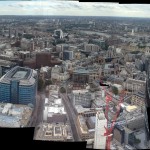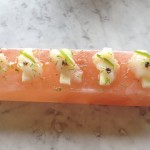I have had the pleasure of eating at too many amazing places to remember. But, of the ones I do remember, it’s often a combination of fantastic food and an amazing dining experience that add-up to make it unforgettable: fresh Lobster on Hellshire Beach, Jamaica; dinner at Toronto’s CN Tower or Lightship Ten that used to be in St Katherine’s Dock; Steak at Palm West in New York; pallela in that bar in El Cotillo, Fuerteventura; or, of course, the half-day eating experience that is The Fat Duck.
Now, today’s lunch venue needs to be added to those experiences. Recently opened on the 40th floor of Heron Tower in the City, Duck & Waffle has fantastic views across East London looking out towards The Olympic Stadium and Canary Wharf and is close enough to give you the impression you are looking down onto The Swiss Re building (the Gherkin). It’s a stunning setting for lunch and, this afternoon, was not too busy so we got a prime table – looking right out East. There aren’t really that many skyscrapers in London and even fewer restaurants with that kind of view: the only taller buildings are Canary Wharf and the Shard (and that’s not open yet).
Of course it’s not just the experience, the food has to be excellent too: and it was. The bbq-spiced crispy pig ears might not sound to your taste but were crispy, meaty and – for somebody who never adds salt to food – nicely salted. If you don’t like tomato, a plate of English-grown heritage tomatoes will make you rethink with a broad range of tastes, colours and flavours while scallop on apple with black truffle and lime was one of the most refreshing tastes I’ve ever eaten. The signature duck & waffle dish is a beautiful mixture of crispy duck and soft waffle.
It must have been good, I don’t think I’ve ever written about a restaurant here before. If you’re in London go before it becomes popular (in a couple of weeks they are about to open 24-hours) and, even if you’re not in the mood for food, try the house Manhattan, the bottled cinnamon smoke that’s a vital constituent is incredible, and you’ll need it: a stiff drink is required after the 30 second glass elevator ride up the outside of the tower.
I took a few pictures of the view (and the food) and they’re all over on Flickr (with a few on Facebook too).





